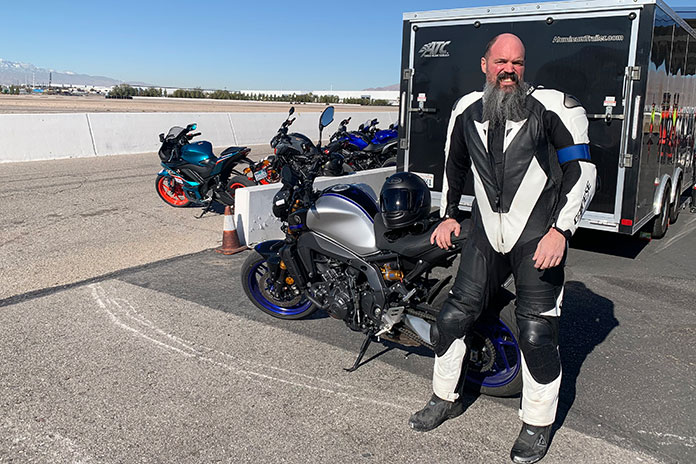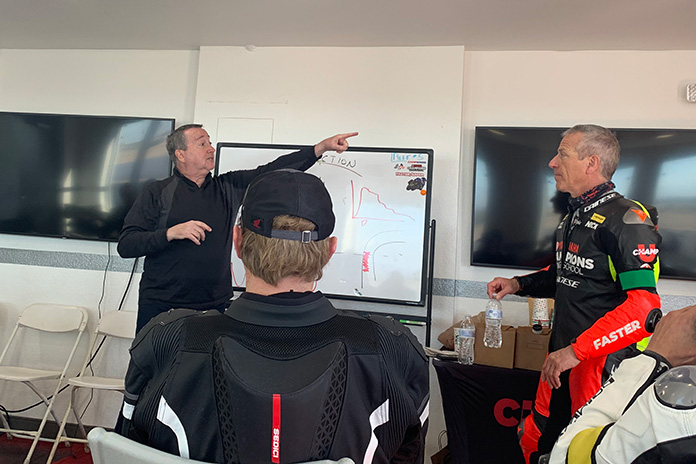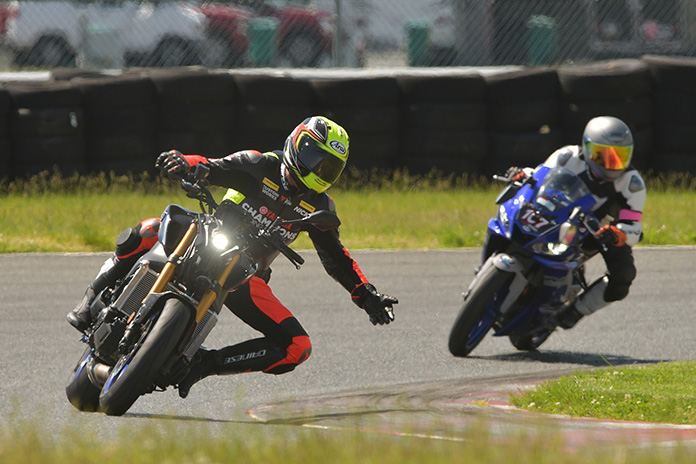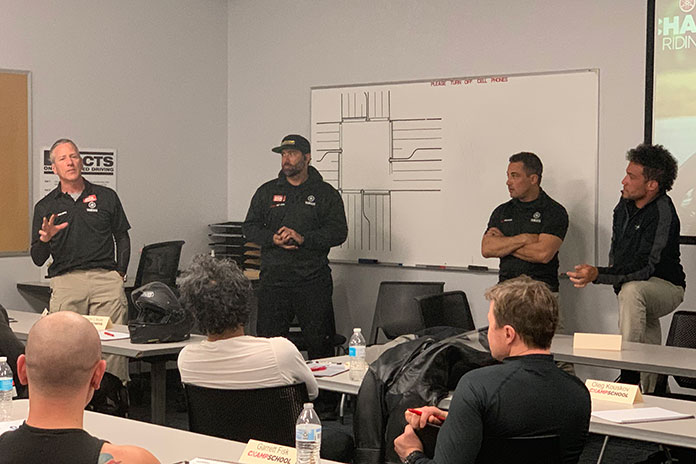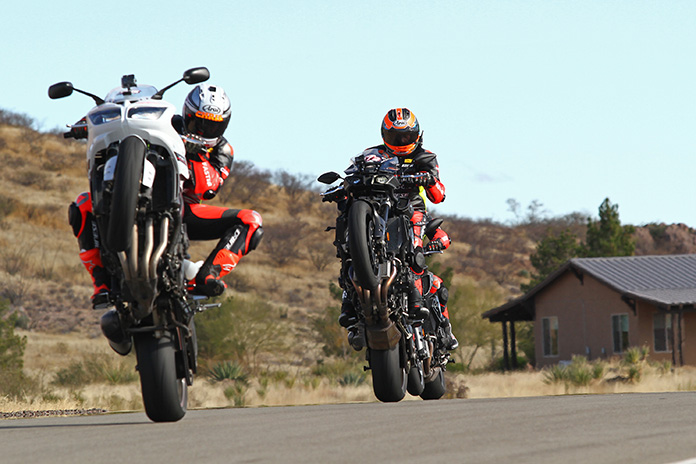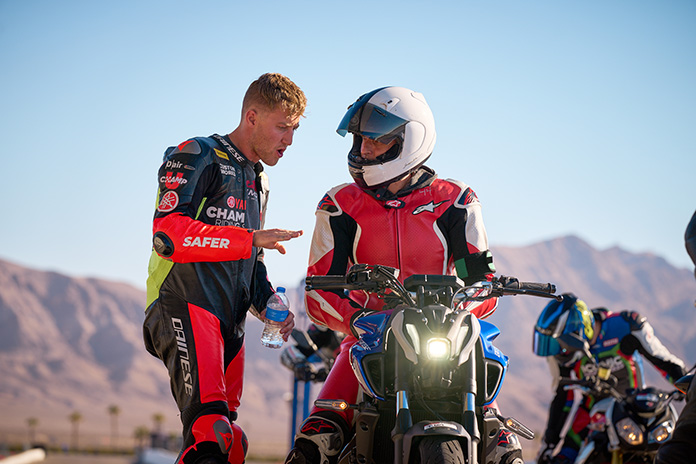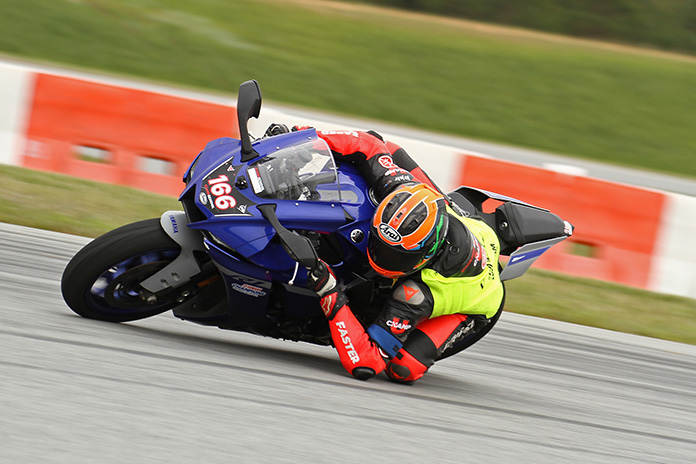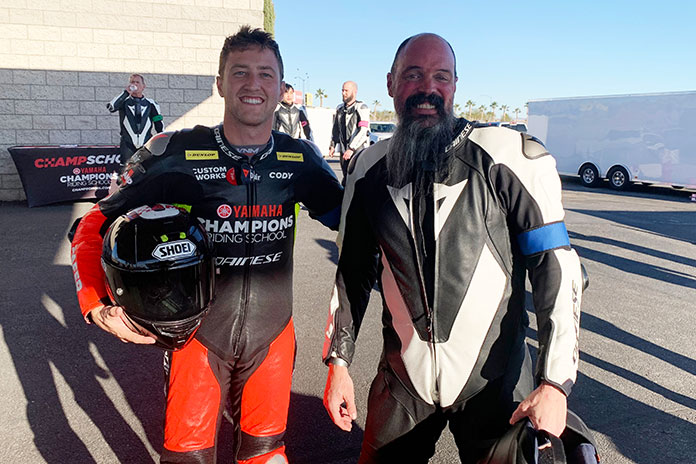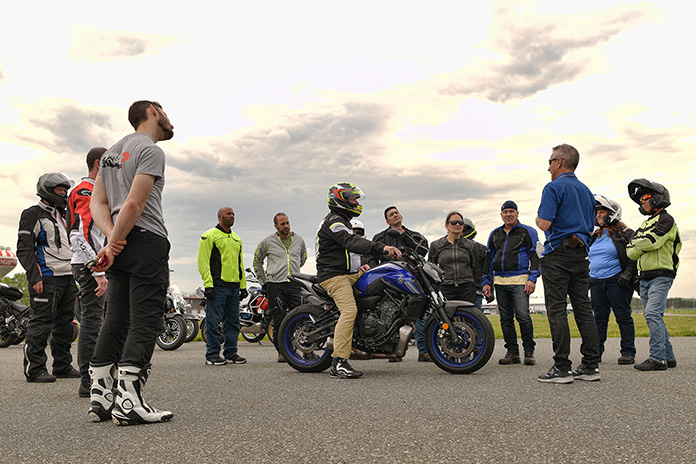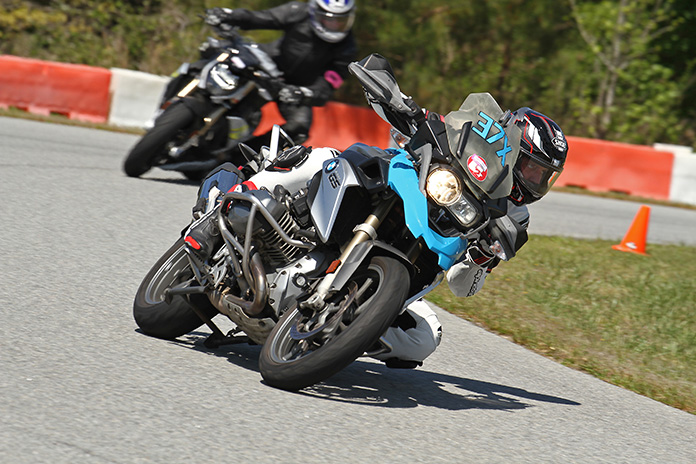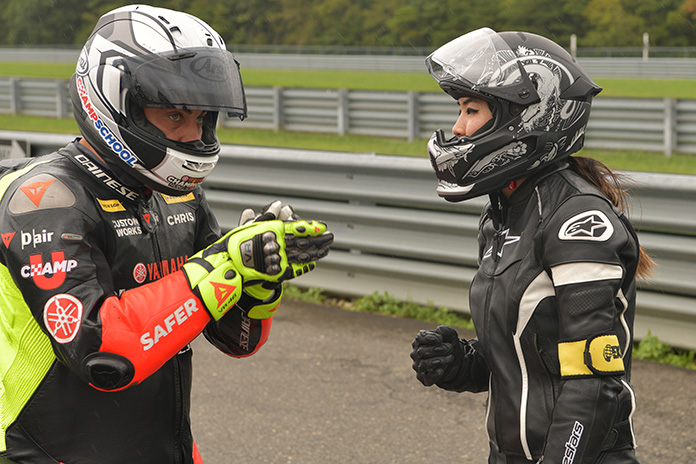The item at the top of associate editor Paul Dail’s resolutions list for 2023 was to get some track experience by attending the two-day ChampSchool offered by Yamaha Champions Riding School. Yamaha was kind enough to loan us an MT-09 SP, and YCRS Chief Instructor and CEO Nick Ienatsch was kind enough to extend Paul an invitation for the Jan. 27-28 ChampSchool at Las Vegas Motor Speedway, which featured “Fast” Freddie Spencer as a guest instructor. –Ed.
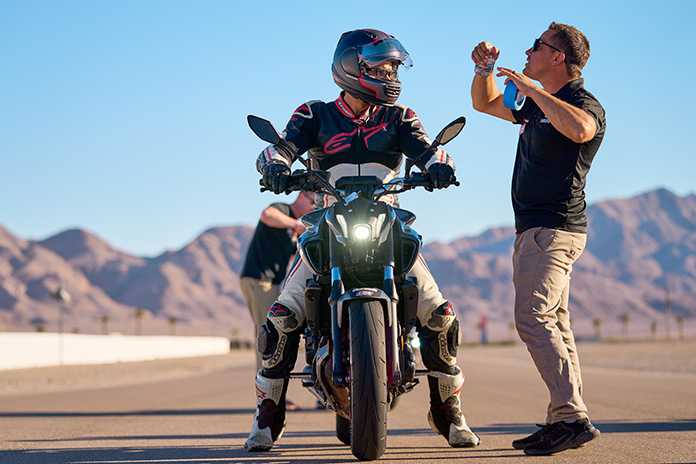
Not much about me screams either “sportbike” or “trackday.” With a shaved head and beard nearly as long as my face is tall, to look at me, you’d probably guess I ride a Harley. And you wouldn’t be wrong. My main bike currently is a 2004 Heritage Softail Classic. I’m a cruiser guy. But the length of my beard might belie the length of time I’ve been riding – at least this most recent stint. According to a website I found with a glossary of both common and obscure motorcycling terms, I’m a “BAB,” or Born Again Biker, which is “someone who has recently returned to riding after a period of absence…and really ought to get some advanced training.”
I’ve taken a couple MSF parking-lot classes that were informative, but when the opportunity arose to pick up a Yamaha MT-09 SP test bike in Southern California and take it to the Yamaha Champions Riding School’s two-day ChampSchool in Las Vegas, I jumped at it. I may be a cruiser guy about to turn 50, but I still have a pulse, and the idea of learning from some of the best racers in the country got that pulse, well, racing.
Related: Yamaha Announces 2023 Updated and Returning Models
Preparing to ‘Ride Like a Champion’
Prior to the school, I was sent the online Champ U “Champion’s Habits: Core Curriculum.” I talk more about this in the sidebar below, but in the immediate, it was very helpful to watch the courses before attending the class. Much of the information was repeated within the first couple hours at the Las Vegas Motor Speedway, but this method of instruction made perfect sense to me. It’s the same reason I usually have my 10-year-old son read through all the instructions before jumping into a project. That way, once you actually get down to business, you understand the big picture – where you’re going and how you’re going to get there. I was pleased that most things the instructors at ChampSchool said in those first hours were lessons I remembered from Champ U.
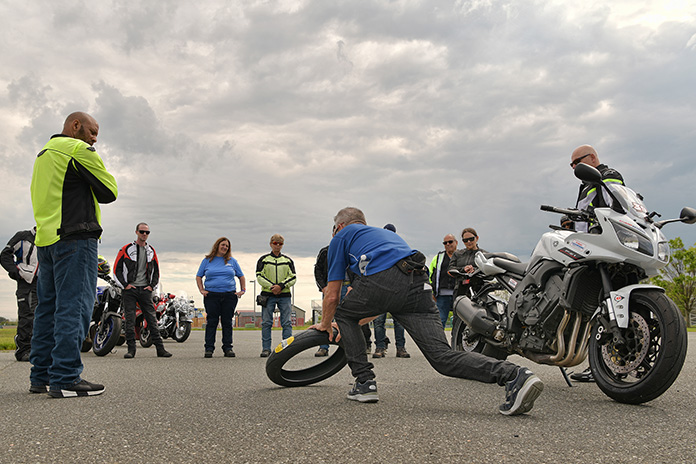
That’s not to say that I wasn’t still nervous. After all, even if you’ve read the instructions, sometimes you break the little pieces when you’re building a model. I wasn’t particularly interested in breaking the $12,000 motorcycle that didn’t belong to me…or the little pieces that make up my body.
Related: 2023 Yamaha MT-10 SP | First Ride Review
But my mind was put to ease by one of the first things ChampSchool Chief Instructor and CEO Nick Ienatsch instructed us to do: Turn to the person standing next to us and say, “I don’t care what you think about my riding.” I’m guessing that even after that, most attendees at the class probably actually did care, myself included, but that was just me dealing with my own insecurities, and starting the two days with that directive was a good reminder. More importantly, even though I was one of the slower riders, I was never made to feel that way by the instructors.
It also helped that the approximately 25 students were divided into two groups depending on track and general riding experience (and then further divided into an approximate 4:1 student-instructor ratio). The two groups would alternate sessions on the track and sessions in the classroom reviewing the time they had just spent on the track and reinforcing other concepts. The only time all of us were on the track together was toward the end of the second day – at which point it wasn’t so nerve wracking being passed by the more advanced students, and I was able to keep my focus on my riding.
Strength Through Struggles
In between each track session, students were asked to rank themselves from 1-10 on a scorecard of “CHAMPS” categories (Comfort/fun, Have brakes past tip-in/efficiency, Apexes/direction, My plan/eyes, Position/timing of body, Smooth initial/final 5%). My three lowest scores were consistently related to braking, scanning forward, and my body position.
While “eyes” was obviously tied to “My plan” (scan ahead on the track and make a plan), the benefit of the CHAMPS scorecard during the classroom sessions was that it gave riders another kind of plan: the things they needed to work on when they went back on the track.
Another great feature of the school is the filming and reviewing of student riding, which happened twice, once toward the end of the first day and then again before lunch on the second day, with the review of the footage happening at the meal after the filming.
In order to move the process along, students were either taken out two at a time to watch their riding with an instructor on a laptop or their riding was reviewed on a larger projector screen with the whole group. For the review of my first ride, I was one of the smaller two-at-a-time groups. I’m not sure if this was by design, but I was glad I didn’t have to watch my puttering along in front of the whole group. And after getting almost a blow-by-blow analysis of the entire ride by my instructor, I was pleased to see improvement in the second-day video (thankfully, since this one was viewed in front of the main group). And like with the CHAMPS scorecard, watching the videos gave me a plan for when I returned to the track.
ChampSchool ‘Roller Coaster Moments’ and Other Surprises
The cost of attending the two-day school at the Las Vegas Speedway was $2,495 (prices vary depending on the track), not counting travel or rental costs for a bike if you don’t bring your own or the required “standard track gear” – in my case, track leathers and boots. This is a little higher than some fees I’ve seen, but considering the bona fides of the instructors, the quality of instruction, the amount of track time, and the online curriculum sent in advance of the class, I think it’s a solid value.
However, there were a couple experiences where it felt like the organizers and instructors thought, Let’s give them an even bigger bang for their buck. I called these the “Roller Coaster Moments.” There were lessons to be gleaned from each one, but mostly I just walked away glad to be alive.
The first one was shown in the online curriculum…kind of. At several points in the videos, instructors hop in a minivan to illustrate how riding can be similar to driving. Makes sense. And so it also made sense when, after some introductory instruction at the speedway, they said, “Okay, let’s get in the minivans, and we’ll illustrate some of these things we’ve been talking about.” Sure, I thought. I remember seeing them doing this in the videos.
What they didn’t show in the videos is the extreme version of illustrating the points.
Did you know a minivan can take corners at 80-plus mph? I didn’t. Nor did I necessarily think it should. My instructor for the two days (and minivan driver that first day) was Cody Wyman. In addition to all of Cody’s racing accolades, he is also a professional driving instructor. Again, did you know a minivan can take corners at 80-plus mph? Apparently it can, although my death grip on the underside of my seat (you can probably still see my claw marks) was because I was convinced we were going to go ass-over-teakettle.
Cody was sure to check in on all his passengers as we careened around the track, and I think I mumbled something like “I’m good,” and I think he said some other things we were supposed to be learning, but it wasn’t until they repeated the exercise the next day that I was able to breathe and pick up some of the finer nuances of braking and finding the straightest lines to the next apex.
The second “Roller Coaster Moment” was riding two-up with an instructor. I’m not sure what else to say besides it was like being on the back of a rocket. I don’t remember much beyond trying not to collapse Cody’s lungs or fracture his ribs with my arms as I clutched the grab bar that had been affixed to the Yamaha MT-10 tank in front of him while he took corners at speeds that I’m pretty sure were faster than the minivan. At least the van had seatbelts.
While I joke about this being a “Roller Coaster Moment,” the lesson was indeed solid, and it segues into my biggest surprise – or perhaps realization – of exactly how amazing motorcycles are when it comes to moving through space and time, especially sportbikes – even with my 200-lb butt on the pillion.
Several times over the course of the two days, we were told to trust the bike. We all hear about “lean angle” and “rider triangle” and “geometry,” but it was fascinating (and reassuring) to hear from professionals exactly how much these machines have been designed to take your physical inputs and convert them using math and science into results that allow the bike to cling to the earth in seeming defiance of natural laws. But I learned that they’re actually pushing those very laws.
Common ChampSchool expressions like “Load the tire before you work the tire” revolve around math and science. Adding 5% of brakes starts to compress the fork, which changes the geometry of the bike and widens the tire’s contact patch, and suddenly (well, similar to his dislike of words like “flick” or “grab,” Nick would probably scold me for such an “abrupt” word choice as “suddenly”) you can add more brakes or lean angle to make a tight corner. It’s more than “man and machine”; it’s an amazing symbiosis. We are riding the motorcycles, and they are listening to what our bodies are saying.
It’s also worth noting I was a little surprised about the caliber of the instructors, not only in their accomplishments but also – and maybe more importantly – their behavior. Nick may have started the class by saying that they would be hard on us, but what I found from all the instructors was positive correction and consistent support and encouragement. And Cody was about the nicest guy you could imagine. Someone could say, “Well, sure, because you were paying them,” but a few weeks after ChampSchool at the AIMExpo show, with hundreds of attendees, I was wandering around trying to take it all in when I heard, “Hey Paul!” It was Cody. I hadn’t even noticed him, and he could’ve just let me pass, but instead he stopped me and took a minute to talk. He didn’t have to do that, but the fact that he did spoke volumes to me.
Related: 2023 AIMExpo Highlights
ChampSchool Final Takeaways
I attended ChampSchool for two reasons: to become a better at my job with Rider, especially when I need to attend a bike launch at a track, and to become a better rider. I’m sure you want to feel like I’m a competent associate editor, but you’re probably reading this to know whether you will become a better rider if you attend ChampSchool. For me, it was mission(s) accomplished.
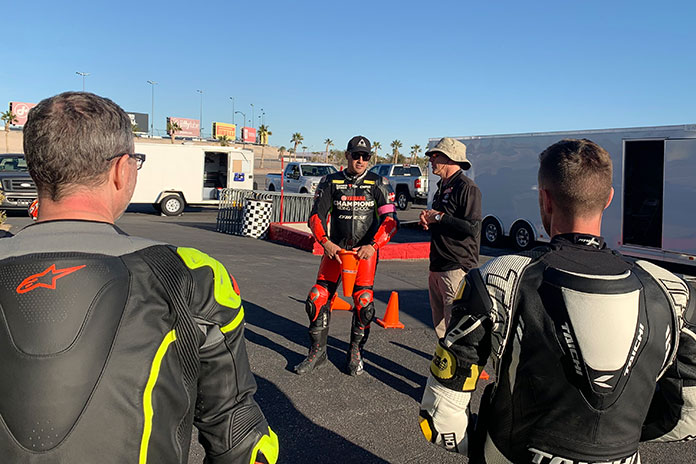
Between Las Vegas and my hometown in southern Utah, there’s a great 12-mile stretch of interstate (yes, interstate) through the Virgin River Gorge, with tall canyon walls and lots of curves. Riding home after ChampSchool, I trusted my bike and I trusted myself. I centered myself and repeated my mantra as I rode toward the slice in the mountains where the interstate cut into the towering walls, and I opened it up a little more through the gorge, as traffic was relatively thin that day.
Still cautious but more confident, I pushed myself. The catchphrases that were repeated in both the online curriculum and at the class echoed in my head – load the tire before you work the tire, brake until you’re happy with speed and direction, and a host of others – and a stretch of road that had been a little more intimidating than enjoyable just a few days earlier was now more fun and exciting.
So thank you to Nick, Cody, and everyone else involved with ChampSchool for taking this cruiser guy and making me a better rider…and making the ride more enjoyable.
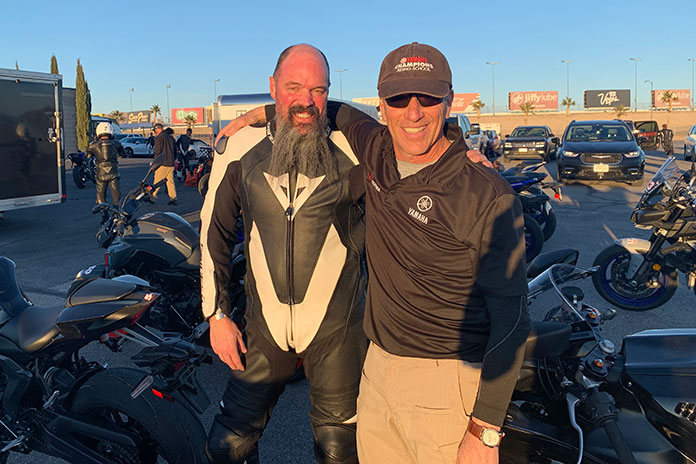
For more information, including upcoming ChampSchool classes, as well as other course offerings, such as the one-day ChampStreet program, which is geared more toward street riding, visit the Yamaha Champions Riding School website.
SIDERBAR: Champ U
While the Champ U online Core Curriculum is available for free as part of ChampSchool, for those who are unable to attend one of the ChampSchool events, purchasing the Core Curriculum independently is an excellent alternative, especially considering it’s on sale for only $49.95 as of publication.
For that cost, you get 12 modules comprising a total of 43 video lessons (most ranging from 3-7 minutes long) and corresponding quizzes. The 12 subjects run the gamut – from front and rear braking, downshifting, and body position to mental approach, the 100 points of grip, and a concept they call “radius=mph” – and there are more than 30 drills to reinforce these lessons.
If it seems like there is some overlap, you’re right, and as a former teacher, I can tell you that learning comes from repetition, a tactic Champ U employs very effectively when topics intersect one another. In fact, a decent amount of the information was familiar to me already, but much like I still regularly ride the test course at my local DMV, I also think it’s valuable to hear the same information from a different perspective. And along those lines, the Champ U content creators know how to turn a phrase. Nearly two months after the class, many of the pithy catchphrases from the Core Curriculum still roll around my head as I roll around on my bike.
They also effectively use humor, which keeps the content from feeling like you’re back to studying up for your motorcycle endorsement. Video production value is good, and most of the instructors look very comfortable on the other side of the camera.
The information is largely geared toward track riding and sport bikes, but they drew several parallels to street riding. Even where they didn’t, as primarily a street rider, I made several connections between the lessons and my own experiences. And once you buy it, it’s yours to revisit as often as you’d like.
And if you know someone who is considering taking up riding or if you are new or recently returning to riding, Champ U is now offering a “New Rider” class with 35 lessons, 28 quizzes, and drills designed to prepare students for life as a motorcyclist at an introductory price of $19.95.
More information at the Champions University Champ U courses webpage.
The post A Cruiser Guy Goes to Yamaha ChampSchool first appeared on Rider Magazine.
Source: RiderMagazine.com

